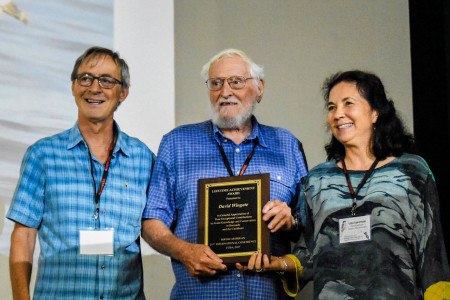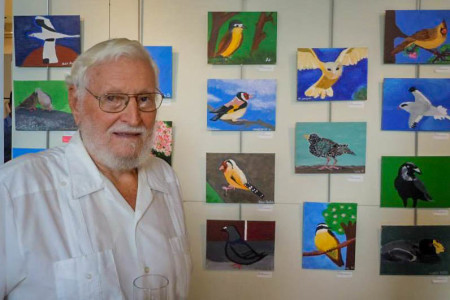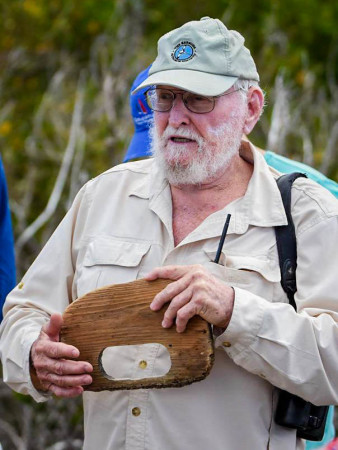
At the recently concluded BirdsCaribbean 21st Conference Meeting in Cuba, Dr. David Wingate was honoured with a Lifetime Achievement Award in recognition of his “exceptional knowledge and contributions to avian knowledge and conservation in Bermuda and the Caribbean”.
David Wingate was born in 1935 in Bermuda, he studied Zoology at Cornell University and went on to become the Conservation Officer for the Bermuda Government Parks Department from 1966 to his retirement in 2000.
For almost 300 years, no Cahows were reported from Bermuda (or anywhere else) until occasional corpses were found on the islands through the first half of the 20th Century. In 1950, David Wingate was a 15 year-old schoolboy in Bermuda, and was certain that the bird survived and must be breeding somewhere on the islets at the entrance to Castle Harbour. He determined to locate the nests and took a kayak across the bay to search for them. The sea was too rough for him to land, but he returned the following year with the eminent seabird biologist Robert Murphy, and nesting Cahows were found.

However, the species was still critically endangered. There were only a handful of pairs, and in 1951 perhaps eight chicks were reared. David Wingate determined to save this bird from extinction and has spent most of his life spent endeavouring to do so. Problems were faced and surmounted. Nest burrows were frequently taken over by White-tailed Tropicbirds Phaethon lepturus and the contents destroyed. Wingate designed and installed ‘bafflers’ with an entrance too small for tropicbirds but allowing access for Cahows. There were few burrows on the islets. Wingate created artificial burrows – with access ports so the nests could be monitored. By his retirement in 2000, the population had grown to over 50 pairs.
Crucially David mentored and trained Jeremy Madeiros to take over the recovery programme. Birds are now breeding on six islands including birds translocated onto Nonsuch Island. The Cahow population continues to grow with a record 117 pairs and 61 fledglings in 2017.
The re-discovery of the Cahow’s breeding grounds was his inspiration for a life involving birds and natural history. He is also credited with rediscovering the Black-capped Petrel in Haiti in 1963. The restoration of the once barren Nonsuch Island into a ‘Living Museum of pre-colonial Bermuda’ is Dr. Wingate’s lifetime work, and part of his effort to bring back from near-extinction Bermuda’s national bird, the Cahow. He has been a crucial part of Bermuda Audubon Society (since its formation in 1954) and a founder of the Bermuda National Trust. He also served on the board of the Bermuda Institute of Ocean Sciences, and as a research associate of the Bermuda Zoological Society.

David’s conservation efforts have been wide-ranging, focussing on many species including the Green Sea Turtle Chelonia mydas, Bermuda Rock Skink Plestiodon longirostris, Yellow-crowned Night-Heron Nyctanassa violacea, and Bermuda population of Common Tern Sterna hirundo, Eastern Bluebird Sialia sialis, and White-eyed Vireo Vireo griseus. It is remarkable that at 81 years old David Wingate remains an active and leading conservationist on Bermuda. He has been responsible for the creation and restoration of numerous wetland habitats in Bermuda.
Amongst his many honours are two from Queen Elizabeth ll and one from the King of the Netherlands. Few Bermudians are known outside their country. David is one of those who commands respect for his conservation efforts. The success of the Nonsuch Island restoration project is used as a model worldwide. The success of the Cahow recovery programme is known throughout the world. He is quite simply the most influential, passionate, knowledgeable and untiring conservationist and naturalist that Bermuda has ever seen.

Great life-time achievement award for a life-time conservation effort.
Congrats to Dr. David Wingate.
Thanks Matt, we were so pleased to have Dr. Wingate at our conference in Cuba and to give him this award. It was an emotional moment and one of the highlights of the conference.